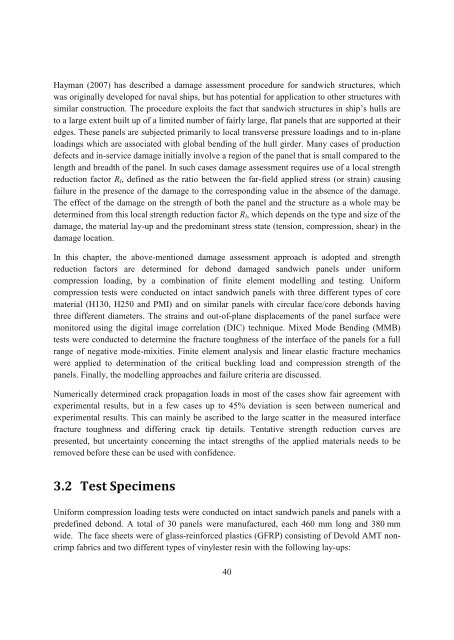Residual Strength and Fatigue Lifetime of ... - Solid Mechanics
Residual Strength and Fatigue Lifetime of ... - Solid Mechanics
Residual Strength and Fatigue Lifetime of ... - Solid Mechanics
You also want an ePaper? Increase the reach of your titles
YUMPU automatically turns print PDFs into web optimized ePapers that Google loves.
Hayman (2007) has described a damage assessment procedure for s<strong>and</strong>wich structures, which<br />
was originally developed for naval ships, but has potential for application to other structures with<br />
similar construction. The procedure exploits the fact that s<strong>and</strong>wich structures in ship’s hulls are<br />
to a large extent built up <strong>of</strong> a limited number <strong>of</strong> fairly large, flat panels that are supported at their<br />
edges. These panels are subjected primarily to local transverse pressure loadings <strong>and</strong> to in-plane<br />
loadings which are associated with global bending <strong>of</strong> the hull girder. Many cases <strong>of</strong> production<br />
defects <strong>and</strong> in-service damage initially involve a region <strong>of</strong> the panel that is small compared to the<br />
length <strong>and</strong> breadth <strong>of</strong> the panel. In such cases damage assessment requires use <strong>of</strong> a local strength<br />
reduction factor Rl, defined as the ratio between the far-field applied stress (or strain) causing<br />
failure in the presence <strong>of</strong> the damage to the corresponding value in the absence <strong>of</strong> the damage.<br />
The effect <strong>of</strong> the damage on the strength <strong>of</strong> both the panel <strong>and</strong> the structure as a whole may be<br />
determined from this local strength reduction factor Rl, which depends on the type <strong>and</strong> size <strong>of</strong> the<br />
damage, the material lay-up <strong>and</strong> the predominant stress state (tension, compression, shear) in the<br />
damage location.<br />
In this chapter, the above-mentioned damage assessment approach is adopted <strong>and</strong> strength<br />
reduction factors are determined for debond damaged s<strong>and</strong>wich panels under uniform<br />
compression loading, by a combination <strong>of</strong> finite element modelling <strong>and</strong> testing. Uniform<br />
compression tests were conducted on intact s<strong>and</strong>wich panels with three different types <strong>of</strong> core<br />
material (H130, H250 <strong>and</strong> PMI) <strong>and</strong> on similar panels with circular face/core debonds having<br />
three different diameters. The strains <strong>and</strong> out-<strong>of</strong>-plane displacements <strong>of</strong> the panel surface were<br />
monitored using the digital image correlation (DIC) technique. Mixed Mode Bending (MMB)<br />
tests were conducted to determine the fracture toughness <strong>of</strong> the interface <strong>of</strong> the panels for a full<br />
range <strong>of</strong> negative mode-mixities. Finite element analysis <strong>and</strong> linear elastic fracture mechanics<br />
were applied to determination <strong>of</strong> the critical buckling load <strong>and</strong> compression strength <strong>of</strong> the<br />
panels. Finally, the modelling approaches <strong>and</strong> failure criteria are discussed.<br />
Numerically determined crack propagation loads in most <strong>of</strong> the cases show fair agreement with<br />
experimental results, but in a few cases up to 45% deviation is seen between numerical <strong>and</strong><br />
experimental results. This can mainly be ascribed to the large scatter in the measured interface<br />
fracture toughness <strong>and</strong> differing crack tip details. Tentative strength reduction curves are<br />
presented, but uncertainty concerning the intact strengths <strong>of</strong> the applied materials needs to be<br />
removed before these can be used with confidence.<br />
3.2 Test Specimens<br />
Uniform compression loading tests were conducted on intact s<strong>and</strong>wich panels <strong>and</strong> panels with a<br />
predefined debond. A total <strong>of</strong> 30 panels were manufactured, each 460 mm long <strong>and</strong> 380 mm<br />
wide. The face sheets were <strong>of</strong> glass-reinforced plastics (GFRP) consisting <strong>of</strong> Devold AMT noncrimp<br />
fabrics <strong>and</strong> two different types <strong>of</strong> vinylester resin with the following lay-ups:<br />
40
















